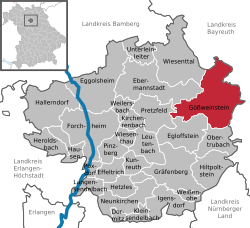Gößweinstein
| Gößweinstein | ||
|---|---|---|

View of the town
|
||
|
||
| Coordinates: 49°46′N 11°19′E / 49.767°N 11.317°ECoordinates: 49°46′N 11°19′E / 49.767°N 11.317°E | ||
| Country | Germany | |
| State | Bavaria | |
| Admin. region | Oberfranken | |
| District | Forchheim | |
| Government | ||
| • Mayor | Georg Lang (CSU) | |
| Area | ||
| • Total | 57.70 km2 (22.28 sq mi) | |
| Elevation | 312 m (1,024 ft) | |
| Population (2016-12-31) | ||
| • Total | 4,022 | |
| • Density | 70/km2 (180/sq mi) | |
| Time zone | CET/CEST (UTC+1/+2) | |
| Postal codes | 91327 | |
| Dialling codes | 09242 | |
| Vehicle registration | FO | |
| Website | www.goessweinstein.de | |
Gößweinstein is a municipality in the district of Forchheim in Bavaria in Germany. It lies within the region known as Franconian Switzerland.
The first record of Goswinesteyn Castle is from 1076. Prior to 1102 the Hochstift Bamberg became the owner of the castle. The prince-bishop of Bamberg Friedrich Carl von Schönborn (ruled from 1729 until 1746) elevated Gößweinstein's status to a Market. During the Secularization in 1803, the area of the Hochstift Bamberg was transferred to Bavaria. During the Bavarian territorial reforms in 1978, the formerly independent communities of Morschreuth, Wichsenstein, Behringersmühle, Kleingesee, Leutzdorf, Stadelhofen, Unterailsfeld and part of the community Tüchersfeld were integrated into Gößweinstein.
The municipal council in Gößweinstein has 16 members plus an extraofficial mayor.
(local elections on March 3, 2002)
...
Wikipedia



